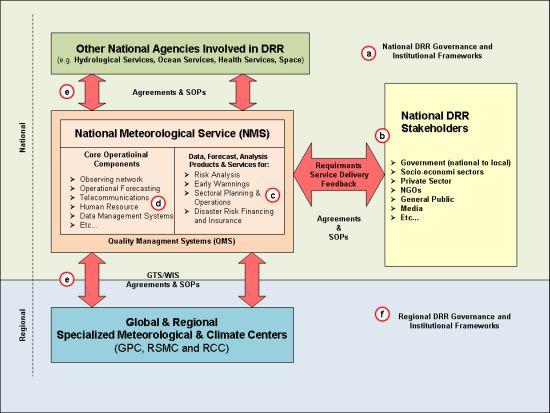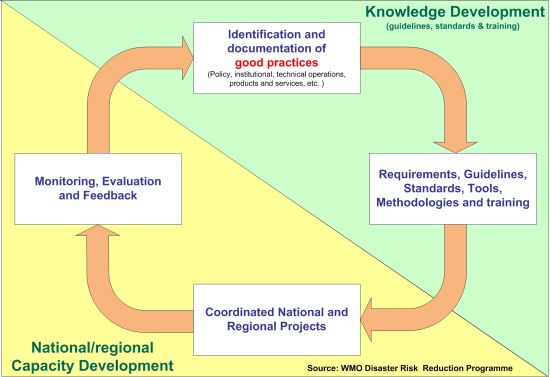| Disaster Risk Reduction (DRR) Programme |
 |
Programmes > DRR >
WMO DRR Programme Thematic & National/Regional Projects
Disaster Risk Reduction (DRR) is a priority for the World Meteorological Organization (WMO) because the protection of lives, property and livelihoods are at the core of the priorities of the WMO Members and the National Meteorological and Hydrological Services (NMHSs). Furthermore, the implementation of the Hyogo Framework for Action 2005-2015(HFA) by national governments is leading to changes in national DRR policies, legal and institutional frameworks, with implications on the role, responsibilities and new working arrangements for the NMHS. These changes provide opportunities such as increased recognition of the NMHS by their governments and stakeholders, which could result in strengthened partnerships and increased resources. However, NMHS face new challenges and liabilities related to the provision of products and services to larger and more diverse group of DRR stakeholders (e.g. government authorities, public and private sectors, Non-Governmental Organizations, general public and media) who have direct responsibilities for DRR decision-making. |
|
|
To meet these new challenges, as illustrated in Figure 1, WMO's crosscutting DRR two-tier Work Plan (hereafter referred to as the DRR Work Plan) aims to facilitate better alignment of the activities of WMO constituent bodies and global operational network as well as those of its strategic partners to assist NMHSs through coordinated projects to:
-
Engage effectively in the National DRR governance and institutional frameworks;
-
Identify, prioritize, establish partnerships and service delivery agreements with national DRR user community engaged in various DRR activities such as risk analysis, Multi-Hazard Early Warning Systems (MHEWS), sectoral risk management, disaster risk financing and transfer (DRR users);
-
Develop and deliver core and specialized products and services (e.g., data, forecasts, analysis, technical advices and a range of other value-added products and services) defined by the requirements of the “DRR users” for DRR decision support (e.g., hazard/risk analysis, multi-hazard EWS, sectoral risk management and disaster risk financing and risk transfer) in a cost-effective, systematic and sustainable manner;
- Ensure that core operational capacities (e.g., observing networks, forecasting systems, telecommunication systems, data management systems, human resources, etc.) are built upon the principles of Quality Management Systems (QMS) to support product and service development and delivery;
-
Establish partnership agreements with other national technical agencies (e.g., hydrological services, ocean services, etc.) and with global and regional specialized centres (e.g. Global Producing Centres (GPC), Regional Specialized Meteorological Centres (RSMCs), Regional Climate Centres (RCC), Tsunami Watch Centers, etc.), with standard operating procedures; and
- Engage in regional and global efforts for development of risk information for large scale and trans-boundary hazards, through strengthened regional and global cooperation.

Figure 1: Schematic representation of linkages between meteorological services and DRR stakeholders
Making the DRR Work Plan a reality requires substantial building of the operational capacities of many NMHSs in developing countries which can only be achieved through successful and well-focused and coordinated capacity development activities. As one strategy for achieving this, significant efforts have been taken to engage WMO Members, regional associations, technical commissions and programmes, to develop strategic alliances with key partners at regional and international levels to implement the DRR Work Plan.
The DRR Work Plan (Figure 2) includes a two-tier approach linking, (i) development of guidelines, standards and training modules for DRR thematic topics based on documentation and synthesis of good practices; and (ii) coordinated DRR and climate adaptation national/regional capacity development projects, to support capacity development of NMHSs for delivery of meteorological, hydrological and climate services as per Figure 1 items a-f. A critical aspect of the coordinated DRR national/regional projects is strengthening of cooperation among NMHS, RSMCs, RCCs, RCOFs and other DRR user-interface mechanisms for development of products and services underpinned by user needs and requirements.

Figure 2: Two-Tier Schematic of the Implementation Approach of the DRR Services
